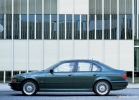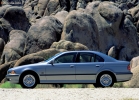BMW Crash Test 5 E39 1995 - 2000 Sedan
BMW Crash Test 5 Sedan Series 1995, 1996, 1997, 1998, 1999, 2000: Laboratory Car Safety Assessment: Rankings in points, test report (photo and video crash test)
25%
Driver and passengers
8%
Pedestrians
Protection of the driver and passenger
 Frosting, driver |
 Front punch, passenger |
 Side blow, driver |
|
Children's holding devices
| Child up to 18 months | BMW Junior, face forward |
| Child older than 3 years | BMW Junior, face forward |
Pedestrian safety
 |
|
Comments:
After the initial test, when airbags worked with the receipt, the manufacturer made changes to the design of the car. Changes included a new collision sensor, safety belt load limiters and additional welding places for leg niches. Here are the results of the tests of the modified vehicle. With a frontal impact, the upper part of the driver's body was protected well, and with a lateral level, the level of protection corresponded to the requirements of 1998. The side airbag for head protection also showed a good result. However, pedestrian protection turned out to be bad - the bumper and the hood is recognized especially attendant.Front punch:
When the doorway is impaired, it is not deformed not much, and the body structure remains holistic. The front airbags showed a good result, and the safety belts load limiters reduced the risk of damage identified at the initial test. In the knee zone, hard elements were found, the blow of which can lead to injury knees, top of the legs or driver's pelvis.Security of passenger children:
The pictogram of the European Association of Manufacturers (ASEA) on the Central Rack and Text Message in English and German Languages \u200b\u200bwarn the driver about the danger of installing a children's chair "against the direction of movement" in the forefront. However, they do not mention the likelihood of getting dangerous injuries with such an installation. In addition, experts noted the short-life of warnings - textual can be lost when replacing windshield. Both children were placed in BMW Junior chairs installed "in the direction of movement" equipped with additional floor supports that prevent excessive offset in a collision. However, these chairs did not meet the requirements due to the lack of color marking of the seat belt trajectory. Each chair reliably fixed his passenger's head when hit by side.Side strike:
Side airbags for breast protection and heads were included in the basic configuration of the car. The latter are designed to prevent head impact on objects outside the car. However, in 1998, a special test for verification of their effectiveness was not carried out, therefore, the overall rating of the car did not affect their presence. When you hit the side of the side, the back door opened, because of what the unused passengers could fall out of the car. Chest airbag guided hand, ribs and abdominal driver, but its effectiveness did not reach the best results identified in this class of cars.Pedestrian safety:
The manufacturer must pay more attention to this aspect. The front part of the car was particularly attendable: 12 of 18 control points were low estimated.General information about the car
| Roelf location | Left |
| Tested model | BMW 520i. |
| Body type | 4-door sedan |
| Year of publishing data | 1998 |
| Curb weight | 1485 |
| The results are valid for VIN, starting with ... | WBADD11000BN64341. |
Installation Systems:
| Pretensels of front seat belts | There is |
| Front Belts Load Loaders | There is |
| Driver Front Airbag | There is |
| Passenger Front Airbag | There is |
| Side airbags | There is |
| Side Head Airbags | There is |
| Driver's knees and feet airbag | No |













